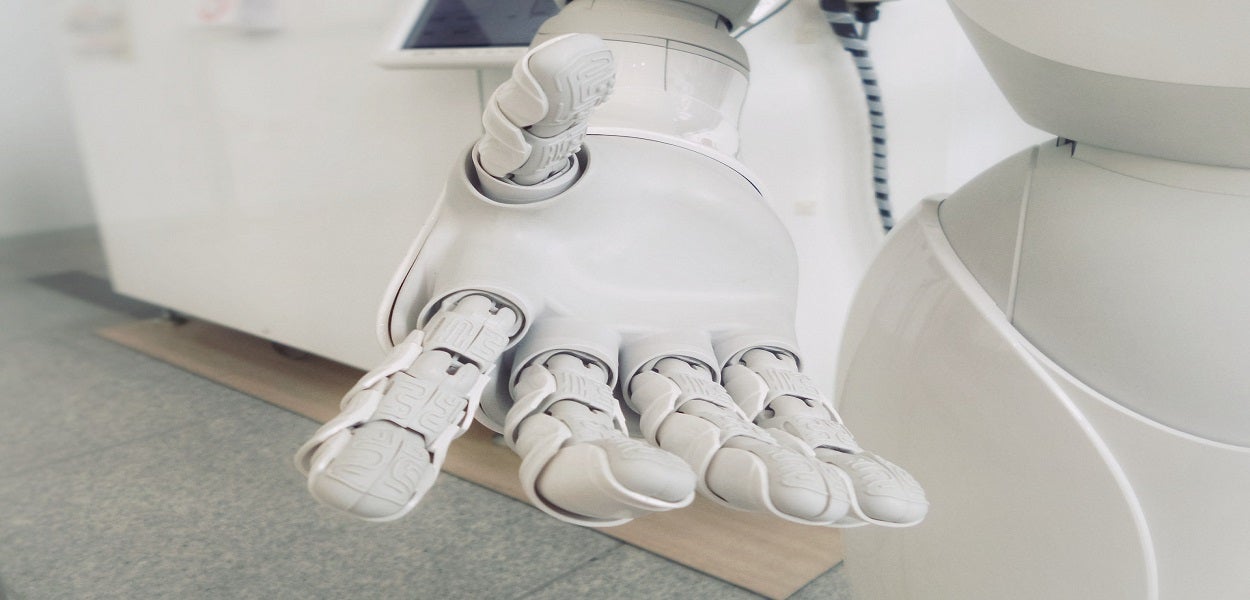The meaning of AI and generative AI
AI stands for artificial intelligence: algorithms and methods that perform complex tasks that previously required human intelligence. Artificial intelligence analyses and uses data faster and often better than humans.
Nowadays, when people think of AI, they think of generative AI. Generative AI can generate information such as text, images, videos or computer code using generative models. A well-known example is ChatGPT, which responds to typed commands (prompts).
What do robots and AI have to do with each other?
Guszti Eiben specialises in robots. He is professor of Artificial Intelligence and head of the Computational Intelligence group at Vrije Universiteit Amsterdam. But what exactly do robots and AI have to do with each other? Eiben explains: “Classical robotics is straightforward technology. The latest development is that robots are becoming increasingly intelligent. Their brains are being programmed with complex algorithms, such as neural networks. That falls within the field of AI.”
Genuinely intelligent AI needs brains and body
Eiben’s goal is to create genuinely intelligent AI. For that, both a brain and a body are needed. This led him to robots, which have both. A robot’s “body” consists of components like the torso, arms and legs, sensors and synthetic parts. The “brain” is formed by the algorithms that control these components.
It may sound logical that both brain and body are needed for intelligence, but “embodied AI” is revolutionary, Eiben emphasises. “Embodied AI is different from the AI we see all around us: digital AI, which makes up the vast majority of AI in our daily lives. Think of Netflix suggesting which series we might also like. Or smart chatbots built with complex language models.”
Inspired by nature
How do you create the best embodied AI? By taking inspiration from nature. After all, there’s already a proven method for developing an effective body: evolution.
Eiben is working on artificial evolution in his bio-inspired robotic lab. In 2016, a robot baby was “born” there – a worldwide first in which two robots reproduced.
“Adaptability is essential for intelligence”
What exactly is the genuine intelligence that the AI professor wants to create? “That’s a philosophical question. But what sets humans apart is our enormous learning ability. We can adapt to our environment exceptionally well. That’s essential for intelligence.”
In the robot lab, Eiben researches how robots adjust to their circumstances. He gives them a task: walk as fast as possible past a number of markers. Through evolution, robots develop an suitable body and a matching brain – allowing them to perform the task optimally.
Not just the brain, but the learning algorithm behind it
These robots are examples of learning machines: machines designed in such a way that they’re able to learn. Eiben’s students can take courses on learning machines, in which they’re given a robot. However, they’re not allowed to program it to simply “pick up this object”. Instead, they have to take it a step further: creating the learning method that will enable the robot’s brain to develop.
This learning method can then be applied to other tasks, such as “find the way out of this maze”. Eiben explains: “With a learning method, the robot can independently learn to adapt to its environment. That adaptability is essential for intelligence.”
Learning machines versus machine learning
The term learning machines sounds a lot like machine learning, but the difference is significant. Machine learning is learning through an algorithm – based on data that humans feed into AI models, Eiben explains. This is almost the opposite of learning machines: machines that can learn independently, like the intelligent robots in his robotic lab.
Is AI machine learning?
Machine learning is a form of AI. A good example is a music service that recommends songs based on your listening behaviour. The algorithm detects patterns and clusters them into recommendations.
AI and deep learning
Deep learning refers to more complex algorithms: optimising or training artificial neural networks consisting of multiple layers, whereby each layer processes data from the previous layers. Deep learning is the technology behind many AI applications, such as real-time speech translation and self-driving cars.
Are the robots taking over?
Are increasingly intelligent robots a threat to humanity? No, says AI expert Eiben. “While we can create adaptability in robots, making them highly intelligent, robots do not act out of self-preservation like humans do. Moreover, robots lack self-awareness. And that, along with adaptability, is another essential element of intelligence.”
Robot babies taking control: “Not in my lab”
Eiben is not afraid of dystopian scenarios. However, he does believe that scientists must consider future risks: “Anticipate the rise of robots, even if those dangers don’t yet exist.”
A potential risk in his own robotic lab is that robot babies might reproduce, meaning you can no longer control their development. Eiben explains: “It sounds like science fiction, but the risk is real. Every living being reproduces in a ‘decentralised’ way – there’s no central control over it. But our robots are not allowed to do that. We deliberately opted for a single, central ‘birth clinic’ where all robot babies are created for artificial evolution. That’s my solution to prevent our creations from taking over.”
The future of robots and AI
Over the next ten years, Eiben predicts several developments:
- Many robots will not resemble humans but will take on shapes best suited to their environment and tasks – just as a robot vacuum cleaner is designed low enough to fit under the sofa. Which shapes? That’ll depend on their application.
- Robots will become self-learning, and continuously improve themselves.
- Robots will be able to change shape – not through evolution, but like transformers that adapt their bodies to different tasks. “Imagine your robot vacuum cleaner developing an arm to pick up scattered socks.”


